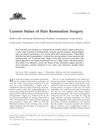Surgical Treatment of Androgenic Alopecia in Clinical Practice
March 2025
in “
Bulletin of the Medical Institute of Continuing Education
”

TLDR FUE hair transplant is the best surgical treatment for hair loss, offering natural and lasting results.
The document reviews the treatment of androgenic alopecia, highlighting the prevalence of the condition in up to 80% of Caucasian men. It emphasizes the importance of surgical methods, particularly the FUE (Follicular Unit Extraction) hair autotransplantation, as the most promising and effective treatment. This method offers stable, natural, and durable results, improving patients' quality of life and reducing reliance on continuous medication. The review analyzed 107 sources and included clinical examples to support its findings.




